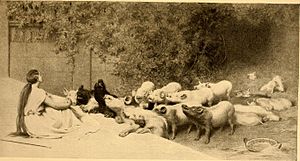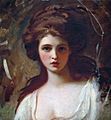Circe facts for kids
In Greek mythology, Circe (pronounced KIR-kee) is a powerful goddess of magic. Sometimes people also called her a nymph, witch, or enchantress. The ancient Greek writer Homer described her as "The loveliest of all immortals."
Circe was known for her amazing knowledge of special plants and magical potions. She could use these, along with a wand, to turn her enemies or anyone who upset her into animals.
Most stories say Circe was the daughter of Helios, the sun god, and Perse, an ocean nymph. Her brothers were Aeetes, who guarded the Golden Fleece, and Perses. Her sister was Pasiphaë, who was married to King Minos and was the mother of the Minotaur. Some other stories say her mother was Hecate, a goddess of magic.
After a difficult event, Circe left her home and went to live on a lonely island called Aeaea. Later stories say she moved to Italy, and people connected her with a place called Cape Circeo.
Circe in Ancient Stories
Homer's Odyssey
One of the most famous stories about Circe is in Homer's epic poem, Odyssey. In this tale, Circe lives in a grand house. It is in the middle of a clearing in a thick forest. Around her house, there were lions and wolves. These animals were not dangerous. They were actually people Circe had turned into animals with her magic. They would act friendly towards anyone who came near.
Circe spent her time working at a large loom, weaving cloth. She invited Odysseus's crew, who were on a long journey home, to a big feast. She offered them a meal of cheese, flour, honey, and wine. But she secretly added one of her magical potions to the food. After the men ate it, she touched them with her wand. Instantly, they all turned into pigs!
Only one of Odysseus's men, Eurylochus, was suspicious. He did not eat the food and escaped to warn Odysseus. Odysseus then bravely set out to rescue his crew. On his way, he met Hermes, the messenger god. Hermes had been sent by the goddess Athena to help Odysseus. Hermes gave Odysseus a special magical herb called moly. He told Odysseus to eat it to protect himself from Circe's potion.
Odysseus followed Hermes's advice. He freed his men from Circe's spell. Odysseus and his crew then stayed on Circe's island for a whole year, enjoying feasts and resting. When it was time for Odysseus to leave, Circe gave him important advice. She told him about two dangerous paths he could take to get back to his home, Ithaca. One path was near the "Wandering Rocks." The other was between the scary monster Scylla and the giant whirlpool Charybdis. These are often thought to be in the Strait of Messina. Circe also told Odysseus how to visit the Underworld to get more guidance for his journey.
Other Greek Stories
In another ancient poem called Theogony by Hesiod, it says that Circe and Odysseus had three sons together. Their names were Ardeas, Latinus, and Telegonus. Telegonus later ruled over a group of people called the Tyrsenoi.
In a story from the 3rd century BC, called the Argonautica, Circe helped a group of heroes called the Argonauts. She performed a special ritual to purify them after they had caused a death. This shows that Circe was seen as a powerful figure in many different myths.
There were also three ancient plays about Circe, but they are now lost. One play by Aeschylus told the story of Odysseus meeting Circe. Old paintings on vases show that the chorus in this play might have been Odysseus's half-transformed animal-men. Another play mentioned how difficult it was for a character to scratch his face after being turned into a pig!
Images for kids
-
Circe and Scylla in John William Waterhouse's Circe Invidiosa (1892)
-
Annibale Carracci's Ulysses and Circe (c. 1590) at Farnese Palace
-
"Circea" in Boccaccio's c. 1365 De Claris Mulieribus, a catalogue of famous women, from a 1474 edition
-
George Romney's c. 1782 portrait of Emma Hamilton as Circe. It was used to illustrate many books.
See also
 In Spanish: Circe para niños
In Spanish: Circe para niños









